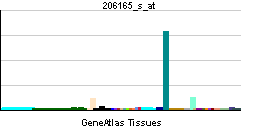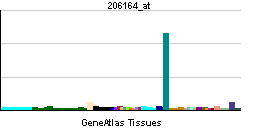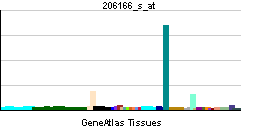CLCA2
| Chloride channel, calcium activated, family member 2 | |||||||||||
|---|---|---|---|---|---|---|---|---|---|---|---|
| Identifiers | |||||||||||
| Symbols | CLCA2 ; CaCC | ||||||||||
| External IDs | Template:OMIM5 Template:MGI HomoloGene: 4765 | ||||||||||
| |||||||||||
| RNA expression pattern | |||||||||||
 | |||||||||||
 | |||||||||||
 | |||||||||||
| More reference expression data | |||||||||||
| Orthologs | |||||||||||
| Template:GNF Ortholog box | |||||||||||
| Species | Human | Mouse | |||||||||
| Entrez | n/a | n/a | |||||||||
| Ensembl | n/a | n/a | |||||||||
| UniProt | n/a | n/a | |||||||||
| RefSeq (mRNA) | n/a | n/a | |||||||||
| RefSeq (protein) | n/a | n/a | |||||||||
| Location (UCSC) | n/a | n/a | |||||||||
| PubMed search | n/a | n/a | |||||||||
Chloride channel, calcium activated, family member 2, also known as CLCA2, is a human gene.[1]
The protein encoded by this gene belongs to the calcium sensitive chloride conductance protein family. To date, all members of this gene family map to the same site on chromosome 1p31-p22 and share high degrees of homology in size, sequence and predicted structure, but differ significantly in their tissue distributions. Since this protein is expressed predominantly in trachea and lung, it is suggested to play a role in the complex pathogenesis of cystic fibrosis. It may also serve as adhesion molecule for lung metastatic cancer cells, mediating vascular arrest and colonization, and furthermore, it has been implicated to act as a tumor suppressor gene for breast cancer.[1]
References
Further reading
- Pauli BU, Abdel-Ghany M, Cheng HC; et al. (2001). "Molecular characteristics and functional diversity of CLCA family members". Clin. Exp. Pharmacol. Physiol. 27 (11): 901–5. PMID 11071307.
- Gruber AD, Schreur KD, Ji HL; et al. (1999). "Molecular cloning and transmembrane structure of hCLCA2 from human lung, trachea, and mammary gland". Am. J. Physiol. 276 (6 Pt 1): C1261–70. PMID 10362588.
- Agnel M, Vermat T, Culouscou JM (1999). "Identification of three novel members of the calcium-dependent chloride channel (CaCC) family predominantly expressed in the digestive tract and trachea". FEBS Lett. 455 (3): 295–301. PMID 10437792.
- Gruber AD, Pauli BU (1999). "Tumorigenicity of human breast cancer is associated with loss of the Ca2+-activated chloride channel CLCA2". Cancer Res. 59 (21): 5488–91. PMID 10554024.
- Gruber AD, Pauli BU (1999). "Clustering of the human CLCA gene family on the short arm of chromosome 1 (1p22-31)". Genome. 42 (5): 1030–2. PMID 10584316.
- Liu QH, Williams DA, McManus C; et al. (2000). "HIV-1 gp120 and chemokines activate ion channels in primary macrophages through CCR5 and CXCR4 stimulation". Proc. Natl. Acad. Sci. U.S.A. 97 (9): 4832–7. doi:10.1073/pnas.090521697. PMID 10758170.
- Koegel H, Alzheimer C (2001). "Expression and biological significance of Ca2+-activated ion channels in human keratinocytes". FASEB J. 15 (1): 145–154. doi:10.1096/fj.00-0055com. PMID 11149902.
- Itoh R, Kawamoto S, Miyamoto Y; et al. (2001). "Isolation and characterization of a Ca(2+)-activated chloride channel from human corneal epithelium". Curr. Eye Res. 21 (6): 918–25. PMID 11262615.
- Abdel-Ghany M, Cheng HC, Elble RC, Pauli BU (2001). "The breast cancer beta 4 integrin and endothelial human CLCA2 mediate lung metastasis". J. Biol. Chem. 276 (27): 25438–46. doi:10.1074/jbc.M100478200. PMID 11320086.
- Abdel-Ghany M, Cheng HC, Elble RC, Pauli BU (2002). "Focal adhesion kinase activated by beta(4) integrin ligation to mCLCA1 mediates early metastatic growth". J. Biol. Chem. 277 (37): 34391–400. doi:10.1074/jbc.M205307200. PMID 12110680.
- Strausberg RL, Feingold EA, Grouse LH; et al. (2003). "Generation and initial analysis of more than 15,000 full-length human and mouse cDNA sequences". Proc. Natl. Acad. Sci. U.S.A. 99 (26): 16899–903. doi:10.1073/pnas.242603899. PMID 12477932.
- Mall M, Gonska T, Thomas J; et al. (2003). "Modulation of Ca2+-activated Cl- secretion by basolateral K+ channels in human normal and cystic fibrosis airway epithelia". Pediatr. Res. 53 (4): 608–18. doi:10.1203/01.PDR.0000057204.51420.DC. PMID 12612194.
- Abdel-Ghany M, Cheng HC, Elble RC; et al. (2004). "The interacting binding domains of the beta(4) integrin and calcium-activated chloride channels (CLCAs) in metastasis". J. Biol. Chem. 278 (49): 49406–16. doi:10.1074/jbc.M309086200. PMID 14512419.
- Connon CJ, Kawasaki S, Yamasaki K; et al. (2005). "The quantification of hCLCA2 and colocalisation with integrin beta4 in stratified human epithelia". Acta Histochem. 106 (6): 421–5. doi:10.1016/j.acthis.2004.08.003. PMID 15707651.
- Connon CJ, Kawasaki S, Liles M; et al. (2006). "Gene expression and immunolocalisation of a calcium-activated chloride channel during the stratification of cultivated and developing corneal epithelium". Cell Tissue Res. 323 (1): 177–82. doi:10.1007/s00441-005-0059-2. PMID 16158324.
- Elble RC, Walia V, Cheng HC; et al. (2006). "The putative chloride channel hCLCA2 has a single C-terminal transmembrane segment". J. Biol. Chem. 281 (40): 29448–54. doi:10.1074/jbc.M605919200. PMID 16873362.
| This protein-related article is a stub. You can help Wikipedia by expanding it. |